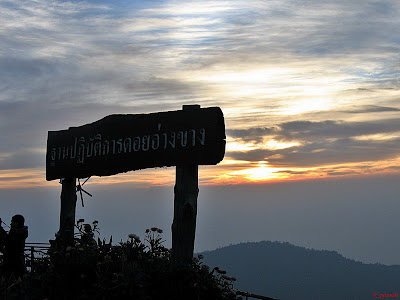
One of the most popular northern destinations that no visitor wants to miss is the National Park on Doi Inthanon, Thailand's highest peak. It was formerly known as 'Aang Ka Luang'. This name came from several elements : its huge raven-shaped rock formation and the large lake which provided a year-round supply of water. Later the area was re-named Doi Inthanon after the remains of Chao Intha‑
Witchayanont, a ruler of Chiang Mai, were permanently relocated there.
Since Doi Inthanon is 2,565 meters above the sea level, its climate is moderate all year round. January however is the coldest month, with temperatures averaging between 5° Celsius to minus zero.
Wild plant species indigenous to Doi Inthanon are considered invaluable to the National Park. These comprise montane

forests, pine forests, dry dipterocarpaceae forests and evergreen forests. Other plants in Doi Inthanon National Park that would yield good economic value include teak, Malabar ironwood, pine, Siamese sal, hiang
(Dipterocarpus obtusifolia), ironwood, Burmese ebony, laurel and makhaa. In addition, there are many different species of orchids such as the Vanda Coerulea, Rhyn gigantea (red) and Paphiopedilum. These, together with the wild roses that grow abundantly all make Doi Inthanon a truly colorful paradise.

Visitors to Doi Inthanon finds themselves caught up with the rare experience of being so close to Mother Nature with its mild weather, the beautiful flowers that dot the landscape, the birds in the air, the village lifestyle of the hill tribes, and most of all the beautiful mountain landscape.

How to get there: By car, leave Chiang Mai Municipality on State Highway #108 (Chiang Mai - Hawd) through Hang Dong and San Pa Tong districts to Chom Thong district. At approximately two kilometers before Chom Thong district, turn right into Provincial Highway #1009 (Chom Thong -Inthanon). Stay on this stretch for another eight kilometers before you arrive at the Doi Inthanon National Park.

















































